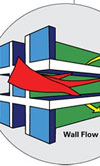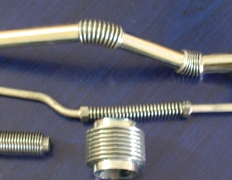Feeling the Pressure
 In previous articles on exhausts, we have talked about how these systems are composed of smaller parts, then welded together to form the whole. We further assumed that these smaller component parts would either be small cast pieces, simple bends or perhaps pressed sections. Pressed sections offer the possibility for different shapes and tight bends where required.
In previous articles on exhausts, we have talked about how these systems are composed of smaller parts, then welded together to form the whole. We further assumed that these smaller component parts would either be small cast pieces, simple bends or perhaps pressed sections. Pressed sections offer the possibility for different shapes and tight bends where required.
In this article we shall look at a technology which is relatively new to motor-racing, although it has been used successfully for decades in the manufacturing industry, and to a limited extent for exhausts. Hydroforming is a process which stretches a pre-form (this can be as simple as a piece of straight pipe) to a given shape.
Whilst this process was, until fairly recently, the preserve of those making small runs of prototype exhausts, it is now finding favour for some limited production aftermarket exhaust systems, especially for the motorcycle market. Again, Corvette are among the avant-garde here (let’s ignore those shouting ‘leaf-springs’), using hydroformed headers on the LS7 engines in the C6R production car.
The first application of hydroforming (certainly that I’m aware of, and I await the barrage of comments telling me that I’m wrong) was used to manufacture two-stroke exhaust systems. Leon Moss at Ledar in England was certainly using this technique around 20 years ago to manufacture expansion-chamber exhausts. In this process, two identically-shaped pieces of sheet metal are welded together along their edges and then ‘blown’ to shape by filling the gap between the sheets with oil, or water is also commonly used, under high pressure. The resultant expanded shapes are basically bent tubes of varying diameter which are then cut into sections and re-welded to form the finished article. No mould tools were involved, and by today’s standards the process was quite basic. There was little stretching of the material, which is one of the fundamental differences to many of today’s processes.

In more modern applications, the hollow exhaust pre-form is inserted into specially designed mould tools, and expanded to fill the cavity in the mould, which is no longer limited to a basic circular cross-section as per the ‘early method’. It is common for the perimeter of the mould section to be greater than the external perimeter of the corresponding pre-form section, and the material is then stretched. Where ‘excessive’ stretching might be required between the pre-form and the finished part, there might be an intermediate stress-relief anneal stage and two sets of tooling used.
The possibilities for the hydroforming part of the exhaust manufacturing process are many – one type of hydroforming uses a sheet pre-form and the work-piece is expanded into the mould by filling a cavity above (or below) the work-piece with the working fluid. This is an alternative method for making parts which might normally be produced by pressing. It can offer an improvement by eliminating stretch marks often seen on deep-drawn parts. As is evident from looking at the Corvette LS7 headers, multiple branched pipes can be made from a single pre-form, and therefore requiring only one (albeit very long) weld. On production vehicles, flexible EGR pipes are often made with hydroformed flexible ‘bellows’ sections. Aside from the manufacturing advantages, people have used this technique to fit exhausts into spaces where packaging is very tight. It has been used in Formula One for this reason.
Written by Wayne Ward.